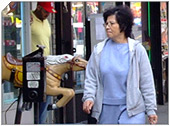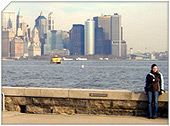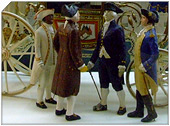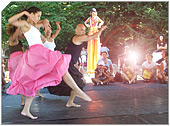Mott Haven, The Bronx, New York City
|
Getting Started
Index
NYC Neighborhoods
Manhattan
Brooklyn
Queens
Bronx
Staten Island
NYC Icons
Chrysler Building
Flatiron Building
Empire State Building
Safe NYC
NYPD
FDNY
NYC Weather
NYC Climate
NYC Weather Forecast
Winter Season
Spring Season
summer Season
Fall Season
NYC History & Politics
New York City History
Tammany Hall and Politics
New York City Politicians
New York City Personalities
Culture of Gotham City
Culture of the city
Cultural diversity
City in popular culture
|
Mott Haven is the southernmost neighborhood in the South Bronx. It is the part of the South Bronx below 149th Street and between the East and Harlem Rivers. Locals often refer to the neighborhood simply as the "South Bronx," while with gentrification, political and real estate interests attempt to change the name to "SoBro." (Ostensibly to conjure the cachet of Manhattan's SoHo neighborhood.)
The area that is now called Mott Haven was originally owned by the Morris family. A small part of the larger swath of land known as Morrisania, it was purchased by Jordan Mott for his iron works in 1849. As the city below grew, the area quickly developed commercially. Many other factories were built, most famously several piano factories around Lincoln avenue, at least two of which are extant. At the same time, an upper-middle class residential area, marked by townhouses built in an elaborate and architecturally daring fashion, started to grow by the 1890s. Soon after, the Bronx grew more quickly, especially with public transit into the area, including the IRT Ninth Avenue Line. By the early 20th century, the population density and relative prosperity of the area supported the construction of many sophisticated Art Deco buildings, many of which still stand along Walton and Jerome Avenues.
Mott Haven was the first neighborhood to give rise to the term "South Bronx". In the 1940s when the Bronx was usually divided into the East Bronx and West Bronx, a group of social workers identified a pocket of poverty in Mott Haven and called it the South Bronx. The pocket of poverty would only spread thanks to Robert Moses building several housing projects in the neighborhood such as John Purroy Mitchel, Mott Haven, Milbrook, and Lester Patterson Houses. This pocket of poverty greatly expanded northward, following the post-war phenomenon colloquially referred to as white flight, reaching a peak in the 1970s when the North Bronx-South Bronx boundary reached Fordham Road. Today the North Bronx-South Bronx distinction remains more common than the traditional East Bronx-West Bronx distinction, and some still regard Fordham Road or the infamous Cross Bronx Expressway as the boundary.
During the dark days, Lincoln Memorial Hospital was moved from the decrepit site at 141st Street and Bruckner Boulevard to a modern facility on 149th Street and Morris Avenue. St. Francis Hospital on 142nd Street and St. Ann's Avenue near St. Mary's Park was closed and turned into a clinic during the 1980s.
In November 1999, Scientific American noted: "The Mott Haven section of New York City's South Bronx has long been one of the poorest neighborhoods in the nation. The median household income of its residents, most of whom are African-American or Hispanic, is less than one third of the U.S. median."
The portion of Mott Haven south and east of the Major Deegan and Bruckner expressways is known as Port Morris. Some artists and professionals have been moving into lofts and historic brownstones in this area, along with a small concentration of new restaurants and cafes. An Antiques District has grown along Bruckner Boulevard and Alexander Avenue, in sight of the old piano and other factories.
In the books, Amazing Grace: The Lives of Children and the Conscience of a Nation and "Ordinary Resurrections: Children in the Years of Hope", author Jonathan Kozol visits Mott Haven and describes the area and what it is like for the people living there. He not only interviews adults but children as well.
|
New York City Search
Quick NYC
|
|
|
 How safe is New York City?
How safe is New York City? Contrary to popular belief, the City consistantly ranks in the top ten safest large cities in the United States. The NYPD is the largest municipal police force in the world and has it's own Movie/TV Unit. |

New York has a humid continental climate resulting from prevailing wind patterns that bring cool air from the interior of the North American continent. New York winters are typically cold with moderate snowfall.  New York Weather Forecast New York Weather Forecast |

New York's two key demographic features are its density and diversity. The New York City metropolitan area is home to the largest Jewish community outside Israel. It is also home to nearly a quarter of the nation's South Asians, and the largest African American community of any city in the country.  Ethnic composition Ethnic composition |

New York Newspapers
 
|



 New York Weather Forecast
New York Weather Forecast
 Ethnic composition
Ethnic composition


















